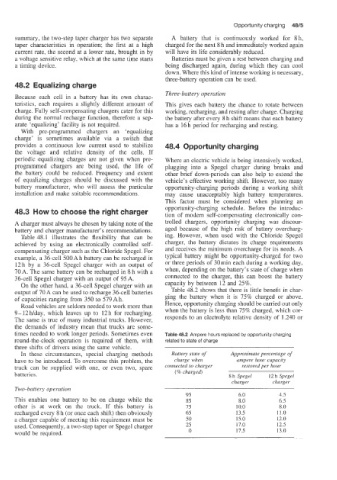Page 498 - Battery Reference Book
P. 498
Opportunity charging 4815
summary, the two-step taper charger has two separate A battery that is continuously worked for 8h,
taper characteristics in operation; the first at a high charged for the next 8 h and immediately worked again
current rate, the second at a lower rate, brought in by will have its life considerably reduced.
a voltage sensitive relay, which at the same time starts Batteries must be given a rest between charging and
a timing device. being discharged again, during which they can cool
down. Where this kind of intense working is necessary,
three-battery operation can be used.
48.2 Equalizing charge
Three-battery operation
Because each cell in a battery has its own charac-
teristics, each requires a slightly different amount of This gives each battery the chance to rotate between
charge. Fully self-compensating chargers cater for this working, recharging, and resting after charge. Charging
during the normal recharge function, therefore a sep- the battery after every 8 h shift means that each battery
arate ‘equalizing’ facility is not required. has a 16 h period for recharging and resting.
With pre-programmed chargers an ‘equalizing
charge’ is sometimes available via a switch that
provides a continuous low current used to stabilize 48.4 Opportunity charging
the voltage and relative density of the cells. If
periodic equalizing charges are not given when pre- Where an electric vehicle is being intensively worked,
programmed chargers are being used, the life of plugging into a Spegel charger during breaks and
the battery could be reduced. Frequency and extent other brief down-periods can also help to extend the
of equalizing charges should be discussed with the vehicle’s effective working shift. However, too many
battery manufacturer. who will assess the particular opportunity-charging periods during a working shift
installation and make suitable recommendations. may cause unacceptably high battery temperatures.
This factor must be considered when planning an
opportunity-charging schedule. Before the introduc-
48.3 How to choose the right charger tion of modem self-compensating electronically con-
A charger must always be chosen by taking note of the trolled chargers, opportunity charging was discour-
battery and charger manufacturer’s recommendations. aged because of the high risk of battery overcharg-
Table 48.1 illustrates the flexibility that can be ing. However, when used with the Chloride Spegel
achieved by using an electronically controlled self- charger, the battery dictates its charge requirements
compensating charger such as the Chloride Spegel. For and receives the minimum overcharge for its needs. A
example, a 36-cell 500A h battery can be recharged in typical battery might be opportunity-charged for two
12h by a 36-cell Spegel charger with an output of or three periods of 30 min each during a working day,
70A. The same battery can be recharged in 8 h with a when, depending on the battery’s state of charge when
36-cell Spegel charger with an output of 95 A. connected to the charger, this can boost the battery
On the other hand, a 36-cell Spegel charger with an capacity by between 12 and 25%.
output of 70 A can be used to recharge 36-cell batteries Table 48.2 shows that there is little benefit in char-
of capacities ranging from 350 to 579 Ah. ging the battery when it is 75% charged or above.
Road vehicles are seldom needed to work more than Hence, opportunity charging should be carried oot only
9-12Nday, which leaves up to 12h for recharging. when the battery is less than 75% charged, which cor-
The same is tnae of many industrial trucks. However, responds to an electrolyte relative density of 1.240 or
the demands of industry mean that trucks are some-
times needed to work longer periods. Sometimes even Table 48.2 Ampere hours replaced by opportunity charging
round-the-clock operation is required of them, with related to state of charge
three shifts of dnvers using the same vehicle.
In these circumstances, special charging methods Battery state of Approximate percentage of
have to be introduced. To overcome this problem, the charge when ampere hour capacity
truck can be eupplied with one, or even two, spare connected to charger restored per hour
batteries. (% charged) 8 h Spegel 12 h Spegel
charger charger
Two-battery operation
95 6.0 4.5
This enables one battery to be on charge while the 85 8.0 6.5
other is at work on the truck. If this battery is 75 10.0 8.0
recharged every 8 h (or once each shift) then obviously 65 13.5 11.0
a charger capable of meeting this requirement must be 50 15.0 12.0
used. Consequently, a two-step taper or Spegel charger 25 17.0 12.5
would be required. 0 17.5 13.0

